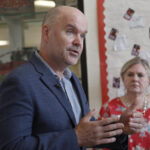INDIAN RIVER COUNTY – America turned over a new leaf last year, when President Barack Obama signed the Healthy, Hunger- Free Kids Act of 2010.
By reducing salt, fat and sugar in school meals, the act created healthier school menus for 31 million children in the United States who eat through school lunch programs, and it aimed to reverse the nation’s growing problem of childhood obesity.
Dr. Melissa Dean, a Vero Beach doctor who specializes internal medicine, said the government has subsidized 25 states, giving guidelines to school systems to help with obesity and develop better food choices in the cafeteria.
“The national obesity level for adults is 27 percent, in adolescents and teens we are up to 17 percent, depending on race and socioeconomic background,” said Dean. “Bottom line, if we want to do what is in our children’s best interest, reduction of diabetes, hypertension and heart disease that comes along with it, is tremendous.”
St. Edward’s has taken its own steps to improve the health of their lower- and middle-school students.
Partnering with Aladdin Food Management Service, the school offers parents access to a database that tracks what their children buy from the school cafeteria.
“Money is deposited by the parents into an account for their kids, and when food is purchased by the student, it shows up for the parents to monitor online,” said Sara Smith, the school’s director of marketing and communication. “It is available to our middle and upper school students. It isn’t required, and a lot of the parents do pack food for the kids.
“I know the parents like the ability to see what their children are eating. It is something they want to have a say in when their kids are here all day.”
“We also don’t serve soda on campus,” Smith added. “That was communicated by the parents as being something they didn’t want.”
By taking ownership of the health of their students, St. Edward’s hopes to positively impact their health decisions for the rest of their lives.
“I think the schools have a tremendous impact, and parenting isn’t quite as easy as it used to be with both parents usually working,” Dean said. “Certainly the public school system is much different than St. Ed’s, so kudos to St. Ed’s. I think that’s awesome.”
Middle school students at St. Edward’s are taught about nutrition, the dangers of drugs and smoking in the classroom.
They find out how companies market unhealthy consumer items like cigarettes and fast food, making it all part of the curriculum on how to live a fit life.
Adolescent diet, combined with physical activity, have proven to the catalysts for an adult’s future health “I think studies (University of Michigan’s), based upon our statistics in the United States with adolescents and teenagers make a huge impact,” Dean said. “When you have education, instead of just letting the kids have free reign, it can help them make wise choices.”




